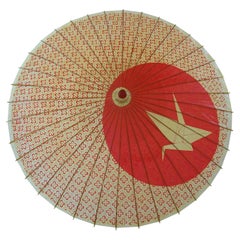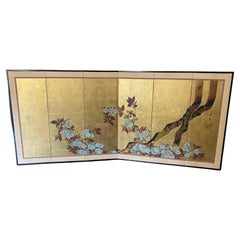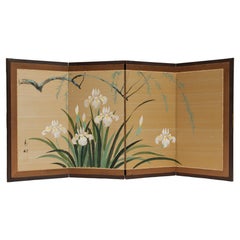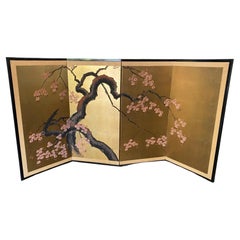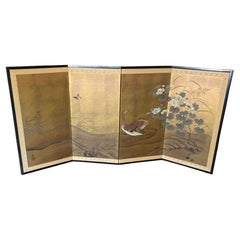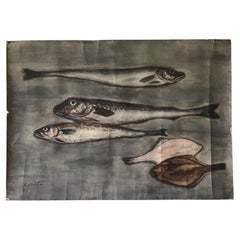Japanese Paintings and Screens
to
147
479
183
877
46
1
22
9
1
115
353
409
47
176
81
22
25
2
22
9
1
6
15
10
3
495
491
423
328
312
1,579
1,411
924
440
114
924
921
922
27
24
3
2
2
Place of Origin: Japanese
Vintage Bamboo & Paper Wagasa Umbrella with Orizuru Print - Japan - Circa 1950's
Located in Chatham, ON
Vintage bamboo and oiled paper Wagasa umbrella or parasol - large size - hand made - featuring an Orizuru (origami folded crane) print against a red circle - overall printed textile ...
Category
Mid-20th Century Japonisme Japanese Paintings and Screens
Materials
Bamboo, Paper
Japanese Asian Signed 8-Panel Folding Byobu Showa Cherry Blossom Tree Screen
Located in Studio City, CA
A gorgeous eight-panel (the screen folds in half instead of fourths due to hanging brackets on the back) Showa Period Japanese Byobu folding screen depicting a nature scene with a be...
Category
20th Century Showa Japanese Paintings and Screens
Materials
Gold Leaf
Antique Japanese Double Sided Folding Chamber Screen 19/20th C Japan Cranes
Located in Amsterdam, Noord Holland
A super nice Meiji period 19th or early 20th c Japanese Chamber Screen. Two sided decoration. Also usuable as wall mounted screen.
Stunning piece!
120 x 60cm
Category
20th Century Meiji Japanese Paintings and Screens
Materials
Bronze
Japanese Asian Signed Four-Panel Folding Byobu Showa Cherry Blossom Tree Screen
Located in Studio City, CA
A gorgeous four-panel Showa Period Japanese Byobu folding screen depicting a nature scene with a beautiful cherry blossom tree in full bloom.. The vibrant, rich colors, gold leaf, an...
Category
20th Century Showa Japanese Paintings and Screens
Materials
Gold Leaf
Japanese Asian Signed Four Panel Folding Byobu Screen Landscape Flowers & Geese
Located in Studio City, CA
A gorgeous four-panel Showa Period Japanese Byobu folding screen depicting a nature landscape scene with a two wild geese frolicking among the blossoming spring flowers as another co...
Category
20th Century Showa Japanese Paintings and Screens
Materials
Gold Leaf
1984 Japanese Vintage Watercolor Fish Painting
Located in Chiba, JP
Large vintage watercolor painting on hard paper, 108 x 76.5 cm (42.51 x 30.11in), titled ‘Codfish’ by a Japanese painter, Komata Yoshio (Arakawa-ku, Tokyo), February, 1984. Some cre...
Category
1980s Showa Vintage Japanese Paintings and Screens
Materials
Paper
Portrait of a Lady Japanese Vintage Oil Painting by Yoshito Shibata
Located in Chiba, JP
Vintage oil painting on wooden plate, by a Japanese painter, Yoshito Shibata (1910-1995), circa 1960-70s, 24 x 33.3 x 0.5 cm (9.44 x 13.11 x 0.19in)
Category
1960s Showa Vintage Japanese Paintings and Screens
Materials
Wood
Circa 1900 Japanese Pine Screen Pair. Aged Dragons by Suzuki Shonen.
Located in Kyoto, JP
Suzuki Shonen (1848-1918)
Aged Dragons
A pair of six-panel Japanese screens. Ink and gold leaf on paper.
Dimensions: Each Screen: H. 170 cm x 378 cm (67" x 149")
As with the pair...
Category
Early 20th Century Meiji Japanese Paintings and Screens
Materials
Gold Leaf
Japanese Asian Signed Four-Panel Folding Byobu Nature Tree Blossom Bird Screen
Located in Studio City, CA
A gorgeous four-panel Japanese Kyoto Byobu folding screen depicting a natural landscape scene with blossoming tree flowers, birds and a flowing river or lake. The rich colors, gold ...
Category
Mid-20th Century Showa Japanese Paintings and Screens
Materials
Gold Leaf
Japanese Asian Signed Four Panel Folding Byobu Screen Herons in the Winter Snow
Located in Studio City, CA
A gorgeous four-panel Showa Period Japanese Byobu folding screen depicting a nature landscape scene with a group of Herons frolicking in the snow covered bare Winter branches of a la...
Category
Mid-20th Century Showa Japanese Paintings and Screens
Materials
Silver Leaf
18th Century Japanese Rinpa Screen. White Chrysanthemums. School of Korin.
Located in Kyoto, JP
School of Ogata Korin
White Chrysanthemums
18th Century, Edo period.
A two-panel Japanese screen. Ink, color, gofun and gold leaf on paper.
Dimensions: H. 171 cm x W. 188 cm (67.5” x 74”)
On this two-panel Japanese screen we see blooming chrysanthemums, a flower which embodies the essence of autumn in Japan. Here the traditional floral theme has been simplified and stylized. The bright colors and asymmetrical composition against the delicate gold leaf create a luxurious and ornate work of art. Its background, a strikingly patinated grid of gold leaf, denies any sense of place or time and imbues everything with an ethereal glow. The leaves and stems of the plants are nothing more than pools of mottled color and ink without any outline whatsoever. These are typical Rinpa adaptations of traditional ink painting methods; tarashikomi, or diluted washes of color blended while very wet, and mokkotsu, or “bonelessness,” which creates forms without exterior outlines. The relief work of the rounded flower petals has been obtained by the moriage process (a mixture based on ground shells modeled on the surface of the paper).
On the lower right of the screen, the siganture “Hokyo Korin Jakumyo” and the “Hoshuku” seal can be read. Korin is Ogata Korin, famed for the Irises (Nezu Museum) and Red and White Plum Blossom (MOA Museum of Art) folding screens, both National Treasures. Korin worked in both Kyoto and Edo in the mid-Edo period. Korin was using the art name “Jakumyo” just after he received the Hokyo level, which was in 1701.
This particular screen was published in May of 1961 in the Japanese Sansai Fine Art Magazine*. An in depth article accompanies the photograph of the screen and and a photograph of the signature and seal. This article devotes much of its body to discussing the moriage technique, how it enlivens the chrysanthemum flowers and Korin’s specific skill in using the technique. The article goes on to discuss the most famous works of Korin, utilizing this technique, which were known at the time. Specifically a two-panel screen held in the Honolulu Museum which was discovered in the store-house of Takahashi Soan. A two-panel screen pair which the Nakano family own. A two-panel screen pair with chrysanthemums in moriage in fan designs owned by the Nomura family. Also a small folding screen featuring chrysanthemums held in the Yamato Bunkakan. The article goes on to say that this particular two-fold screen came from the Nijo family. Korin is known to have had a strong connection with the aristocratic Nijo family. The article explains that Korin received a lot of favors from the Nijo family and that this screen would have been gifted to them.
Since that time the Honolulu screen has been amended to ‘attributed to Ogata Korin’ and I do not know further details of the other 3 screens. Other Chrysanthemum screens...
Category
18th Century Edo Antique Japanese Paintings and Screens
Materials
Gold Leaf
Japanese Falconry Watercolor Panels, Set of Three
Located in Bradenton, FL
Set of Three Hand-Painted Japanese Watercolor Panels depicting falconry scenes, dating from the early 20th century. Each vertical panel features a meticulously rendered falcon perche...
Category
Early 20th Century Other Japanese Paintings and Screens
Materials
Paint, Paper
Early 20th Century Japanese Screen. Flowers of the Four Seasons.
Located in Kyoto, JP
Anonymous
Flowers of the Four Seasons
A four-panel Japanese screen. Ink, gofun and pigments on gold leaf.
This Japanese screen is a rich visual celebration of the flowers of the fo...
Category
Early 20th Century Taisho Japanese Paintings and Screens
Materials
Gold Leaf
Japanese Rare Antique Pair Hand Painted Birds And Blue Waters Wedding screens
Located in South Burlington, VT
A lovely antique pair (2) Japanese hand-painted six-panel folding screens byobu- each conceived in an attractive birds, trees, and blue waters motif. Likely given as a wedding gift...
Category
19th Century Meiji Antique Japanese Paintings and Screens
Materials
Wood, Paper
$760 Sale Price / set
20% Off
Japanese Showa Six Panel Screen Tales of Genji on Gilt
Located in Rio Vista, CA
Early 20th century Japanese showa period six panel byobu screen depicting an artistic reinterpretation of a scene from the tales or Genji Monogatari. The miniature style of the paint...
Category
20th Century Showa Japanese Paintings and Screens
Materials
Silk, Wood, Paper
Mid-size 6-panel byôbu 屏風 with a scene from The Tale of Genji
Located in Amsterdam, NL
A refined medium-sized six-panel byôbu (folding screen) showcasing a classical autumn court scene from chapter 7 of The Tale of Genji (Genji Monogatari), titled Momiji no Ga (The Aut...
Category
17th Century Antique Japanese Paintings and Screens
Materials
Metal, Gold Leaf
Mid 19th Century Framed Japanese Painting. Mice & Millet
Located in Kyoto, JP
Obata Tosho (1812-1886)
Mice & Millet
Late Edo period, mid 19th Century
Framed Japanese Painting. Ink and color on paper.
Individually framed 19th century bird and flower paintin...
Category
Mid-19th Century Edo Antique Japanese Paintings and Screens
Materials
Paper
Pair of 18th Century Japanese Edo Screens of Chinese Immortals
Located in Rio Vista, CA
Mesmerizing pair of late 18th/early 19th century Japanese Edo period byobu screens by Shibata Gito (Japanese 1780-1819). The paintings depict Chinese immortals in a dreamy landscape....
Category
18th Century Edo Antique Japanese Paintings and Screens
Materials
Silk, Wood, Paper
Pair of Red and White Plum Blossom Screens After Ogata Korin
Located in Rio Vista, CA
Amazing pair of 18th century Edo period style paintings of red and white plum blossoms after Ogata Korin (Japanese 1658-1716). Reproduction of one of the most famous paintings in Jap...
Category
20th Century Edo Japanese Paintings and Screens
Materials
Brass, Gold Leaf
Antique Japanese Double Sided Folding Chamber Screen 19/20th C Japan Cranes
Located in Amsterdam, Noord Holland
A super nice Meiji period 19th or early 20th c Japanese Chamber Screen. Two sided decoration. Also usuable as wall mounted screen.
Stunning piece!
120 x 61cm
Category
20th Century Meiji Japanese Paintings and Screens
Materials
Bronze
Japanese 4-Panel Byobu Screen
Located in Astoria, NY
Japanese Four Panel Byobu Screen, with hand-painted scenes of flowers within gilt borders, chop seal marks to each panel. Larger panels: 38.75" H x 17.25" W x 1" D. Provenance: From ...
Category
Late 20th Century Ming Japanese Paintings and Screens
Materials
Hardwood, Paper
19th Century Japanese Shunga Hand-Scroll, Katsukawa School
Located in Kyoto, JP
Shunga
Unknown artist
Meiji era, circa 1880
Hand-scroll mounted with 12 paintings
Ink, pigment and gofun on silk
Dimensions:
Each image measures H. 23.2 cm x W. 34.4 cm (9.15” x 13.5”)
The hand-scroll measures H. 28 cm x W. 540 cm (11” x 212”)
A set of 12 late 19th century Japanese Shunga paintings mounted as a hand-scroll. Two of the leaves bear the signature and seal ‘Setsuzan’, although we are unable to confirm the identity of the artist using this art name. 6 of the 12 images are taken almost directly from Katsukawa Shuncho’s late 18th century woodblock series, ‘Erotic Pictures...
Category
Late 19th Century Meiji Antique Japanese Paintings and Screens
Materials
Silk
Early 20th Century Japanese Nihonga Screen. Bamboo Forest.
Located in Kyoto, JP
Anonymous
Bamboo Forest
Early Taisho era. Circa 1910-1915.
Six-panel Japanese Screen. Mineral pigment, gofun and ink on silk.
A six-panel Japanese folding screen, painted on silk in...
Category
Early 20th Century Taisho Japanese Paintings and Screens
Materials
Silk
Antique Japanese Screen six panels.
By Japanese Studio
Located in Brescia, IT
Six-panel screen painted with mineral pigments on rice paper and silver leaf.
Floral scene of a Rimpa school garden with polychrome chrysanthemum flowers, of excellent size.
Soft col...
Category
Late 19th Century Meiji Antique Japanese Paintings and Screens
Materials
Silver Leaf
Early 20th Century Japanese Screen Pair - Ink Pine Trees on Gold
Located in Kyoto, JP
Imao Keisho (1902-1993)
Pine Trees
Early 20th Century, Circa 1930
Pair of six-panel Japanese screens. Ink on silk and gold leaf.
Dimensions: Each screen H. 67.5” x 148” (172 cm x 376 cm)
A pair of monumental six-panel Japanese pine screens by the renowned Nihonga artist Imao Keisho. Here Keisho entirely removed the background and brought the pine trees to the surface of the painting. This simplification of the elements makes the scene exceptionally direct and compelling and injects a very modern...
Category
Early 20th Century Showa Japanese Paintings and Screens
Materials
Gold Leaf
Vintage 20th century Japanese Nude Charcoal Nihonga Drawing by Eiki Tsukioka
Located in Chiba, JP
Charcoal on layered washi (Japanese paper) stuck on wooden canvas, 53 x 65.5 x 1.5cm (20.86 x 25.78 x 0.59in), by Eiki Tsukioka (1916-1997), as one of the leading Showa’s Nihonga (J...
Category
20th Century Japonisme Japanese Paintings and Screens
Materials
Paper, Wood
Early 19th Century Japanese Screen. Cherry Blossom & Pheasants by Mori Tetsuzan
Located in Kyoto, JP
Mori Tetsuzan (1775-1841)
Pheasants and Cherry Blossoms
Two-fold Japanese screen. Ink, color, gofun, gold and silver on paper.
A two-fold Japanese bir...
Category
Early 19th Century Edo Antique Japanese Paintings and Screens
Materials
Gold Leaf
17th Century Japanese Screen Pair. Tiger & Dragon by Kaiho Yusetsu
Located in Kyoto, JP
Kaiho Yusetsu (1598-1677)
Tiger and Dragon
Early Edo Period, Circa 1650
A Pair of Six-fold Japanese Screens. Ink and slight color on paper.
Dimensions:
Each screen: H. 171 cm x W. 380 cm (67.5’’ x 149.5’’)
In this pair of early Edo period Japanese screens a group of tigers prowl in a bamboo grove whipped with fierce wind, while a dragon claws through clouds and mist. The dragon embodies elemental qualities - looming out of the mist, the coils of its body disappearing in the clouds. The dragon is calling for rain, symbolizing spring which is considered the fountain of life. On the other side, the tigers calls for the wind, symbolizing autumn which is considered the end of life. Tigers were familiar motifs within Japanese art from ancient times though the animals were imaginary to the people in the 17th century. While dragons and tigers are usually associated as sacred and ferocious, in this painting, both animals have rather amusing expressions. The tigers appear to glare at the dragon with cat-like eyes, and the look on the swirling dragon’s face appears almost affectionate - lending a playful flair to an otherwise magnificent theme.
The tiger and dragon are cosmological symbols of the balancing forces in the world. Screens such as this were originally meant to express the fluctuating nature of the world. For Japanese in the early Edo period, they likely suggested the powers of the cosmos. In Japan the tiger and dragon motif was originally absorbed into the circles of Zen monasteries before spreading into the secular world. The theme especially appealed to the military classes with the Kano school, the official painters to the Shogun and the samurai, being the leading contributors. The painter of this pair of screens, Kaiho Yusetsu (1598-1677), was closely patronized by the third Shogun Tokugawa Iemitsu. In his later years he worked with Kano school artists...
Category
Mid-17th Century Edo Antique Japanese Paintings and Screens
Materials
Silk, Wood, Paper
B57 Japanese Antiques Silver folding screen, 6panels, Sparrows in autumn grass
Located in Niiza, JP
Material: Paper, wooden frame
1 piece: Width 600 x Height 1760 x Depth 17 mm
Expanded size: Width 3640 mm
Folded size: Width 620 x Height 1760 x Depth 100 mm, weight 11 kg
estimate P...
Category
20th Century Japanese Paintings and Screens
Materials
Wood, Paper
Japanese Four Panel Garden Screen with Koi, Iris, & Turtles
Located in South Burlington, VT
Unusual Japanese Four Panel Garden Screen, Mint Condition
Japan, a superb four-panel silk screen byobu depicting a panoramic garden replete with koi, turtles, Iris nestled near a walking bridge and wooden roofed shelter. This attractive screen dates to the early Taisho period.
It is signed Tae.
It is beautifully hand painted with a handsome gold natural light background by a skillful artist painter and is signed with inscription and seal in lower right corner:
Dimensions: 69 inches high and 113 inches wide extended.
Enticing and rare subject matter, this simple rendition of a serene nature setting and size of painting is skillfully and tastefully rendered in mineral paint pigments on silk and with muted soft green and off-white tones depicting a serene nature walk. Perhaps this is someone's dream tea garden. A red lacquered wood perfectly frames this serene and tasteful composition.
Photographed in natural light.
Lifetime guarantee of authenticity: All of our Asian works of art come with our Lifetime Authenticity Guarantee. We are members of the North American Japanese Garden...
Category
Early 20th Century Taisho Japanese Paintings and Screens
Materials
Silk
$7,600 Sale Price
58% Off
Japanese Folding Screen Gold Leaf
By Japanese Studio
Located in Brescia, IT
Byobu painted with mineral pigments on gold leaf, the quality of the painting is still excellent, with no color loss or restorations.
A classic four-panel screen depicting Mount Fuji...
Category
Early 19th Century Edo Antique Japanese Paintings and Screens
Materials
Gold Leaf
Mid-18th Century Japanese Screen Pair, One Hundred Flowers, Chrysanthemums
Located in Kyoto, JP
Omori Soun (b. 1704)
Chrysanthemums - One Hundred Flowers
A Pair of Six-fold Japanese Screens. Ink, color, gofun and gold leaf on paper.
Dating ...
Category
Mid-18th Century Edo Antique Japanese Paintings and Screens
Materials
Gold Leaf
Kiku to Hagi Byobu, Rinpa School Style, Edo Period.
Located in Point Richmond, CA
A Chrysanthemum and Bush Clover painting on gold leaf six-panel folding screen, painted with clusters of leafy green chrysanthemum plants with white blossoms having moriage relief petals of gofun growing amidst pink blossoming bush clover within a bunched bush clover garden fence rendered in lighter gold relief, all on a background entirely of rich gold leaf. These two flowers are symbolic of Japan and the autumn season. The classic patterned paper verso with a Naga Antiques...
Category
Early 1800s Edo Antique Japanese Paintings and Screens
Materials
Gold Leaf
Japanese six-panel folding screen with gold-leaf depicting an idyllic landscape
Located in Milano, IT
A Japanese six-panel folding screen, decorated with gold leaf and gold powder, depicting a landscape with traditional houses nestled among green hills, streams, and bamboo and pine t...
Category
18th Century Antique Japanese Paintings and Screens
Materials
Gold Leaf
Album of Japanese Shunga 28 Paintings Early 20th Century
Located in Norton, MA
Album of erotic paintings. Japan. Early 20th century. Shunga with 28 paintings, real hand-painted. Ink and colors on silk. Brocade mounts. 9.25 x 7in. Image sizes from (4" ~ 4.5") W ...
Category
Early 20th Century Japanese Paintings and Screens
Materials
Silk
Mid 19th Century Japanese Screen Pair. Flowers & Birds of the Four Seasons.
Located in Kyoto, JP
Shioka Sorin (1781-1850)
Flowers & Birds of the Four Seasons
Pair of six-panel Japanese Screens. Ink, gofun and pigments on silk.
Dimensions (each screen): H. 91.5cm x W. 285cm (3...
Category
Mid-19th Century Edo Antique Japanese Paintings and Screens
Materials
Silk
Mid 19th Century Framed Japanese Painting. Snail, Wasp & Hollyhock.
Located in Kyoto, JP
Obata Tosho (1812-1886)
Snail, Wasp & Hollyhock
Late Edo period, mid 19th Century
Framed Japanese Painting. Ink and color on paper.
Individually framed 19th century bird and flow...
Category
Mid-19th Century Edo Antique Japanese Paintings and Screens
Materials
Paper
Circa 1700 Japanese Sliding Door (Fusuma) Set. Pine Trees on the Seashore.
Located in Kyoto, JP
"Pine Trees on the Seashore"
A set of four sliding doors (Japanese fusuma). Ink, color, gold-leaf and gold-fleck on paper.
Dimensions (total display si...
Category
Late 17th Century Edo Antique Japanese Paintings and Screens
Materials
Gold Leaf
Japanese Matching Set of Two Fine Birds And Dragonfly Shoji Doors Screens
Located in South Burlington, VT
Japan, a fine set of two shoji "Birds and Dragonfly" bamboo doors or screens recently acquired from a Japanese private collector. The hand carved boards are artistically cut and ins...
Category
Early 20th Century Taisho Japanese Paintings and Screens
Materials
Bamboo, Wood
Japanese Asian Two Panel Meiiji Edo Folding Byobu Screen Landscape with Birds
Located in Studio City, CA
A gorgeous two-panel Japanese Byobu folding screen depicting a nature landscape scene with a two wild birds frolicking along a riverbank/lakeside among a patch of blossoming flowers....
Category
19th Century Meiji Antique Japanese Paintings and Screens
Materials
Wood, Paper
Circa 1925. Taisho era Japanese Nihonga Screen. Camellia & Bamboo.
Located in Kyoto, JP
Anonymous
Camellia & Bamboo
Taisho era
Two-panel Japanese Screen. Mineral pigment, gofun and ink on silk.
A small Japanese Nihonga screen capturing...
Category
Early 20th Century Taisho Japanese Paintings and Screens
Materials
Silk
Japanese Showa Screen Shell Gathering After Katsushika Hokusai
Located in Rio Vista, CA
Fascinating Japanese Showa period four-panel byobu screen depicting women shell gathering or clamming after the painting by Katsushika Hokusai (Japanese 1760-1849). The women are gat...
Category
20th Century Showa Japanese Paintings and Screens
Materials
Brass
Mid 18th Century Japanese Screen Pair. Crows & Pines by Unkoku Toshuku.
Located in Kyoto, JP
Unkoku Toshuku (1722-1779)
Crows and Pines
A pair of six-panel Japanese Screens. Ink and gold leaf on paper.
Dimensions: Each Screen: H. 170.5 cm x W. 375 cm
Haha-cho or mynah birds, whose forms resemble crows in artwork, were commonly depicted in Japanese art. These types of paintings were originally modeled on paintings attributed to the 13th century Chinese painter Muqi (Mokkei), whose art was enormously influential in Japan. Crows only became a theme among Japanese artists from the later 1500s onward. They likely were inspired by these imported Chinese paintings of myna birds, which are not native to Japan, substituting the native species of crow instead.
The best known early examples of the depiction of Japanese crows are two Momoyama screen...
Category
Mid-18th Century Edo Antique Japanese Paintings and Screens
Materials
Gold Leaf
Japanese Antique Hand Painted Lotus And Blue Waters Screen Vibrant Colors
Located in South Burlington, VT
From our recent Japanese Acquisitions- Hard to Find Lotus Flowers
A stunning Japanese Antique Hand Painted six panel byobu screen on silk executed with lovely lotus flowers and vib...
Category
19th Century Meiji Antique Japanese Paintings and Screens
Materials
Gold Leaf
$1,320 Sale Price
20% Off
Japanese Asian Korean Chinese Signed 4-Panel Folding Byobu Cherry Blossom Screen
Located in Studio City, CA
A gorgeous four-panel hand painted Japanese Asian Byobu folding screen depicting a wildly and brilliantly colorful fully blooming Spring cherry blossom tree with a wonderful composit...
Category
20th Century Showa Japanese Paintings and Screens
Materials
Wood, Paint, Paper
Early 20th Century Japanese Cherry Blossom Screen by Kano Sanrakuki
Located in Kyoto, JP
Cherry Blossoms
Kano Sanrakuki (1898-1981)
Showa period, circa 1930
2-panel Japanese Screen
Color, gofun and gold leaf on paper
Against a backdrop of gold-leafed ground, the lichen covered trunk and branches of the life-sized cherry blossom tree reach out and beyond the confines of the pictorial surface. The overall composition has a feeling of flatness which draws emphasis to the surface and the three-dimensionality of the cherry blossoms. Painstakingly built-up layers of thickly applied shell-white gofun detail the voluminous blossoms and cover large areas of this tour-de-force of Japanese Nihonga painting. By simplifying the background, minimizing the number of colors and depicting the blossoms with such heavy relief, the artist has emphasized the stunning presence of the cherry tree. The type of tree depicted is the Yae-Zakura; a double-layered type of cherry blossom famed for its beauty and strength. When we think of Japanese cherry blossoms, the first thing that comes to mind is Somei Yoshino variety, which has a single flower with five almost white petals. This type is fragile and easily blown away by strong wind or rain. Most of the double-flowered cherry blossoms begin to bloom when the Somei-Yoshino falls, and the flowering period lasts longer than that of the Somei-Yoshino.
Kano Sanrakuki originally studied painting at the Kyoto City Arts and Crafts School under the tutelage of Yamamoto Shunkyo...
Category
Early 20th Century Showa Japanese Paintings and Screens
Materials
Gold Leaf
17th Century Japanese Screen. View of West Lake by Unkoku Toyo.
Located in Kyoto, JP
Unkoku Toyo (1612-1668)
View of West Lake
Pair of eight-panel Japanese Screens. Ink and gold wash on paper.
Dimensions: Each screen: H. 110 cm x W. 372 cm (43” x 147”)
This pair ...
Category
Mid-17th Century Edo Antique Japanese Paintings and Screens
Materials
Paper
Large Japanese 6-panel byôbu 屏風 (folding screen) with genre painting
Located in Amsterdam, NL
Fascinating large six-panel byôbu (folding screen) with a detailed genre painting on goldish silver leaf with different scenes of people at work in a rural mountain village during th...
Category
Early 20th Century Japanese Paintings and Screens
Materials
Silver Leaf
Antique Taisho Period Tanzaku Woodblock Print of Heron at Twilight by Seiko
By Seiko
Located in Philadelphia, PA
A fine antique Taisho period Japanese woodblock print.
Depicting a swooping heron above a riverbed with a thin sliver of a crescent moon in the background.
By Seikо̄. Seikо̄ is tho...
Category
Early 20th Century Taisho Japanese Paintings and Screens
Materials
Paper
Vintage Gold Leaf Lacquer Asian-Inspired Four-Panel Folding Screen
Located in Sheridan, CO
Vintage Black and Gold Leaf Lacquer Asian-Inspired Four-Panel Folding Screen. An Asian-Inspired Four-Panel Screen depicting colorful foliage, floral and grasses on a stunning gold le...
Category
1950s Japonisme Vintage Japanese Paintings and Screens
Materials
Gold Leaf
17th Century Japanese Screen. Ink Plum Tree & Birds by Kano Naonobu.
Located in Kyoto, JP
Kano Naonobu (1607-1650)
Plum Tree and Birds
Six-fold Japanese Screen. Ink and slight color on paper.
In this evocative ink work spread over a six-panel folding screen, we see the consummation of the elegance and refinement of the Edo Kano school. This 17th century screen is a rare surviving example of a large-scale bird and flower painting by Kano Naonobu, the younger brother of Kano Tanyu...
Category
17th Century Edo Antique Japanese Paintings and Screens
Materials
Wood, Paper
Japanese Antique Pair Jade Green Mandarin Duck Screen Holders
Located in South Burlington, VT
A handsome pair of Japanese hand cast Mandarin Duck screen holders with highly detailed plumage possessing a lovely original jade green finish , early Taisho period, early 20th cen...
Category
Early 20th Century Meiji Japanese Paintings and Screens
Materials
Iron
B58 Japanese Antiques, geese & Reeds, silver folding screens set, ink, 8panels
Located in Niiza, JP
Material : paper. wood frame
Unfolded size: 3760 x 1180 mm
Folded size: 470 x 1180 x 105 mm, 7 kg
Estimated size after packaging (sandwiched between 5-10 mm plywood): 20 cm x 55 cm x...
Category
19th Century Antique Japanese Paintings and Screens
Materials
Wood, Paper
Japanese Screen Painting, Early 19th Century, Autumn Flowers by Sakai Hoitsu
Located in Kyoto, JP
A two-fold Japanese screen by the Rimpa school artist Sakai Hoitsu (1761-1828), Japan, 19th century, Edo period.
This small Japanese folding screen pai...
Category
Early 19th Century Edo Antique Japanese Paintings and Screens
Materials
Wood, Silk
Japanese Asian Signed Four-Panel Folding Byobu Showa Screen Tales of the Genji
Located in Studio City, CA
A gorgeous four-panel Japanese Byobu folding screen depicting a scene from the Classic Japanese narrative "Tales of the Genji". The vibrant, rich colors, gold leaf, and beautiful han...
Category
20th Century Showa Japanese Paintings and Screens
Materials
Gold Leaf
Japanese Bamboo & Orchids 4-Panel Byobu Screen
Located in Astoria, NY
Japanese Bamboo and Orchids Scene Four-Panel Byobu Screen, gouache on silk, with iron red six character mark on the lower right panel, in ebonized wood frame. 24" H x 39" W. Provenan...
Category
20th Century Ming Japanese Paintings and Screens
Materials
Silk, Hardwood
Japanese Edo Six Panel Table Screen After Maruyama Okyo
Located in Rio Vista, CA
Fantastic diminutive Japanese Edo period table top screen depicting a lively water landscape with flora and fauna. The screen is beautifully painted o...
Category
19th Century Edo Antique Japanese Paintings and Screens
Materials
Brass, Gold Leaf
Japanese Large Contemporary Yellow Black Gilded Raised Silk Folding Screen
Located in Takarazuka, JP
Japanese contemporary two panel folding screen or "byobu" featuring genryoku style handcrafted raised silk kimono in yellow, black and gold on a cream color background. Tagasode is t...
Category
21st Century and Contemporary Japanese Paintings and Screens
Materials
Silk, Brocade
Japanese Showa Four Panel Screen Flower Vases on Silk
Located in Rio Vista, CA
Charming Japanese four-panel Showa period byobu screen depicting colorful floral arrangements in various vases and baskets. The hand-painted screen features vibrant natural color pig...
Category
20th Century Showa Japanese Paintings and Screens
Materials
Brass
Antique Japanese Taisho Period Byobu Four Panel Folding Screen
Located in New York, NY
Antique Byobu Four Panel Screen.
Japan, late 19th to early 20th century. Taisho period.
Category
Late 19th Century Antique Japanese Paintings and Screens
Materials
Paper
Recently Viewed
View AllMore Ways To Browse
Ogata Korin
Painted Panel Screen Birds
Antique Chinese Black Lacquer Screen
Antique Falconry
Carved Stone Panel
Chinese Carved Hardwood Screen
Chinese Folding Silk Screen Art
Chinese Paint Brushes
Chinese Pearl And Lacquer Screen
Gold Screen Crane
Japanese 4 Panel Screen
Japanese Autumn Screen
Japanese Calligraphy Screen
Japanese Cherry Blossom Screen
Japanese Snow Painting
Kimono Rack
Korean Painted Screen
Rinpa School
